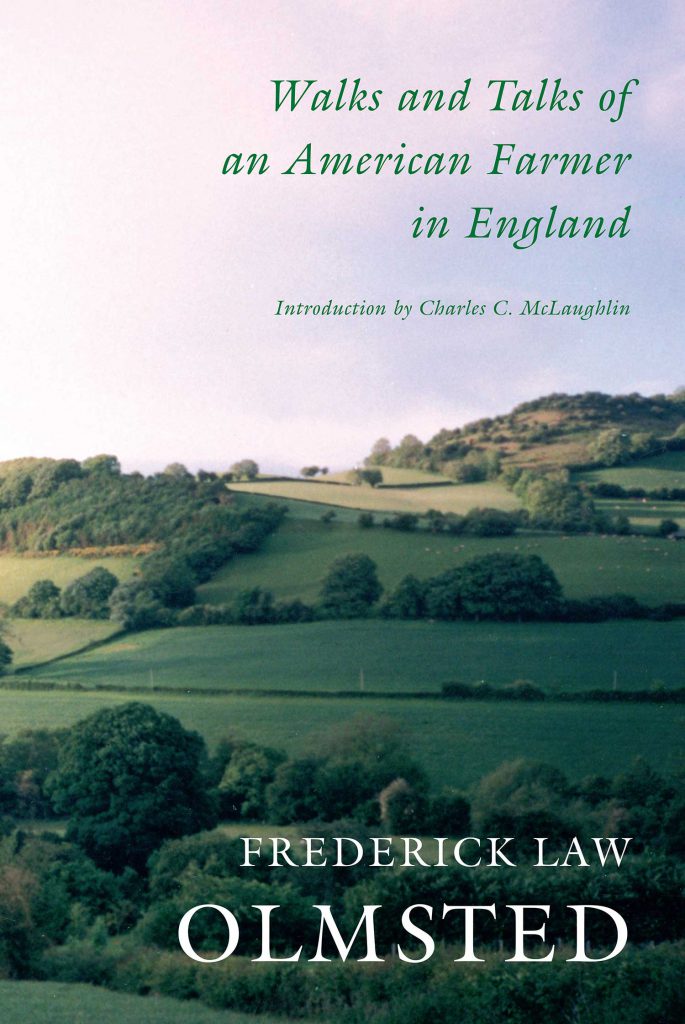Walks and Talks of an American Farmer in England
Frederick Law Olmsted
Reprint of 1852 edition, with a new introduction by Charles C. McLaughlin
Library of American Landscape History
| ISBN: 978-1-952620-07-2 | 592 pages | 5.5 x 8.25 inches |
| $28.00 | Paper | Published: 01/01/2002 |
| 36 b&w photos and woodcuts, map | |
Before he ever dreamed of becoming a landscape architect, Frederick Law Olmsted (1822–1903) visited southern England and Wales during a month-long walking tour. A gifted writer, he recorded his impressions of the trip in this richly detailed volume, which has long been out of print. “In Walks and Talks,” writes Charles C. McLaughlin, author of the book’s new introduction, “Olmsted is reporter, social analyst, narrator, dramatist, scene-painter, and humorist, employing a wide range of modes and styles to give us the sights, sounds, and mental impressions of rural England in 1850.”
Olmsted’s narrative—at turns poetic, funny, critical, and meticulous—is a delight to read. It is also an important historical document, revealing the extent to which England permeated almost every aspect of Olmsted’s emerging worldview, soon to find expression in his various careers as scientific farmer, author and publisher, social critic, reformer, administrator, and landscape architect of major parks and park systems throughout the United States.
The introduction clarifies the links between Olmsted’s developing picturesque aesthetic, social conscience, and reformer’s passion for change. McLaughlin offers a persuasive argument that Olmsted would come to adapt many of the features of the cultivated English countryside—first seen on this trip—in designed landscapes such as New York’s Central Park.
This edition provides extensive annotations to the original text, furnishing background and context to the people and places Olmsted encountered during his journey. McLaughlin’s notes are based on his own trips through England, undertaken over the past two decades to retrace the author’s original route.
“In this book we get not only a young American’s vivid impressions of mid-nineteenth-century England, but also the first glimmers of Frederick Law Olmsted the observant journalist and future landscape designer. Charles McLaughlin’s erudite introduction usefully puts all this in the proper perspective.”
“Olmsted’s first, and most engaging, book . . . Walks and Talks is a charming chronicle of a Connecticut Yankee’s discovery of old scenes and new ideas in the land of his ancestors. The LALH reprint edition of this remarkable journal benefits greatly from the annotation that accompanies Olmsted’s text, while the editor’s gracefully phrased introduction provides a most useful setting for the narrative.”
“It is fascinating to see Olmsted here absorbing and recording firsthand impressions of England’s rapidly changing countryside and growing industrial cities. McLaughlin’s gracefully erudite introduction to this timely republication provides a vivid portrait of a young mid-nineteenth-century traveler.”
About the Authors
Frederick Law Olmsted
Frederick Law Olmsted (1822–1903) was, at turns, a scientific farmer, journalist, park administrator, publisher, public health commissioner, and conservationist, but his contributions to the field of landscape architecture alone would have secured him a reputation as one of the most influential figures of the nineteenth century. Olmsted’s career as a landscape architect began in 1856 when Calvert Vaux persuaded him to enter the competition for the new Central Park in New York City. He and Vaux went on to design Prospect Park in Brooklyn, an extensive park system for Buffalo, New York, and the town of Riverside, outside Chicago.
Fairsted, Olmsted’s Brookline, Massachusetts, practice initially included Charles Eliot, and later his stepson, John Charles, and son, Frederick Law Olmsted Jr., with whom he designed major park systems, university campuses, and suburbs throughout the nation. He and Vaux teamed up one last time to write the plan for the new Niagara Reservation in 1887. Olmsted’s Yosemite Report, written in 1865, established the intellectual basis for a national park system.
Charles C. McLaughlin
Charles C. McLaughlin, Ph.D., (1929-2005) was a professor of history at American University and founding editor of The Papers of Frederick Law Olmsted.
